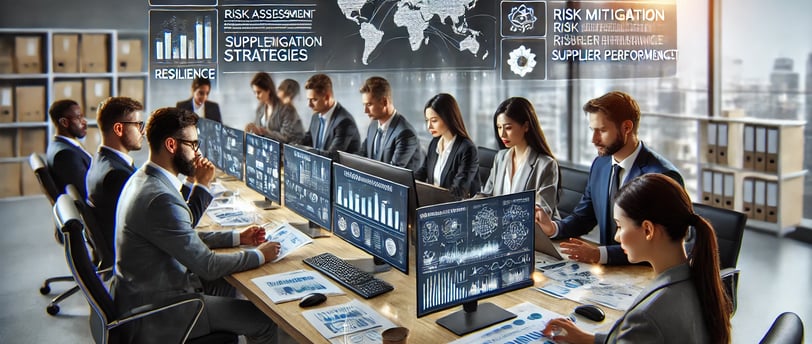Expert Procurement Solutions: Strategies for Effective Supplier Risk Management
Discover expert procurement solutions for managing supplier risk with Novus Procurement. Learn strategies for identifying, assessing, and mitigating risks to build a resilient supply chain.
Arun Raju
7/31/20243 min read


Introduction
Effective supplier risk management is essential for maintaining a resilient supply chain and ensuring business continuity. Novus Procurement offers expert procurement solutions to help organizations identify, assess, and mitigate supplier risks. In this blog post, we explore key strategies for effective supplier risk management.
The Importance of Supplier Risk Management
Effective supplier risk management offers several benefits, including:
Business Continuity: Ensuring uninterrupted operations during disruptions.
Cost Savings: Reducing costs associated with supply chain disruptions and recovery efforts.
Improved Supplier Performance: Enhancing supplier reliability and performance through risk management.
Regulatory Compliance: Ensuring compliance with legal and regulatory requirements.
Enhanced Reputation: Maintaining a strong brand reputation by managing risks effectively.
Key Strategies for Supplier Risk Management
Identifying Supplier Risks
The first step in supplier risk management is identifying potential risks. Key practices include:
Supply Chain Mapping: Creating a detailed map of the supply chain to identify critical nodes and dependencies.
Risk Categories: Categorizing risks such as financial instability, geopolitical issues, natural disasters, and compliance breaches.
Risk Indicators: Establishing indicators to monitor potential risks, such as financial health metrics and geopolitical developments.
Assessing Supplier Risks
Once risks are identified, assessing their potential impact is crucial. This involves:
Risk Assessment Frameworks: Using frameworks like SWOT (Strengths, Weaknesses, Opportunities, Threats) analysis to evaluate risks.
Supplier Audits: Conducting regular audits to assess suppliers' capabilities and risk management practices.
Scenario Analysis: Developing scenarios for various risk events to understand potential impacts on the supply chain.
Mitigating Supplier Risks
Developing strategies to mitigate identified risks is essential for resilience. Key approaches include:
Supplier Diversification: Diversifying the supplier base to reduce dependency on any single supplier.
Buffer Stock: Maintaining buffer stock or safety stock to manage supply disruptions.
Contractual Safeguards: Including risk mitigation clauses in supplier contracts, such as force majeure and penalty clauses.
Supplier Development: Working with suppliers to improve their risk management capabilities and performance.
Monitoring and Reviewing Risks
Continuous monitoring and regular reviews are vital for effective risk management. Key practices include:
Risk Monitoring Systems: Implementing systems to continuously monitor risk indicators and provide real-time alerts.
Performance Reviews: Conducting regular performance reviews to assess supplier risk management efforts.
Feedback Mechanisms: Establishing mechanisms for feedback from suppliers and internal stakeholders to identify emerging risks.
Leveraging Technology for Risk Management
Utilizing technology can enhance supplier risk management. Important technologies include:
Data Analytics: Using data analytics to identify trends and predict potential risks.
Risk Management Software: Implementing software solutions to automate risk assessment and monitoring.
Blockchain: Leveraging blockchain technology for transparency and traceability in the supply chain.
Best Practices for Supplier Risk Management
Establishing a Risk Management Culture
Building a culture of risk management within the organization is crucial. This involves:
Leadership Commitment: Ensuring senior leadership is committed to risk management and sets the tone from the top.
Training and Awareness: Providing training and raising awareness about risk management practices among employees.
Integration: Integrating risk management into procurement processes and decision-making.
Collaborating with Suppliers
Collaboration with suppliers is essential for effective risk management. Best practices include:
Regular Communication: Maintaining open lines of communication with suppliers to discuss risks and mitigation strategies.
Joint Risk Assessments: Conducting joint risk assessments with key suppliers to identify and address risks collaboratively.
Shared Contingency Plans: Developing and sharing contingency plans with suppliers to ensure coordinated responses to disruptions.
Continuous Improvement
Continuous improvement is vital for maintaining effective supplier risk management. This involves:
Regular Reviews: Regularly reviewing and updating risk management practices to address new and evolving risks.
Benchmarking: Comparing risk management practices against industry standards and best practices to identify areas for improvement.
Lessons Learned: Analyzing past disruptions to identify lessons learned and improve future risk management efforts.
Case Studies
Novus Procurement has helped numerous organizations improve their supplier risk management practices, resulting in enhanced resilience and business continuity. Our case studies highlight successful implementations and the tangible benefits achieved through effective supplier risk management.
Conclusion
Effective supplier risk management is essential for building a resilient supply chain and ensuring business continuity. By identifying, assessing, and mitigating risks, organizations can enhance supplier performance, reduce costs, and maintain compliance. Novus Procurement offers expert procurement solutions to help your organization manage supplier risks effectively. Contact us today to learn more about our risk management services.
FAQs
1. What is supplier risk management, and why is it important? Supplier risk management involves identifying, assessing, and mitigating risks associated with suppliers to ensure business continuity, reduce costs, and maintain compliance.
2. How can Novus Procurement help with supplier risk management? Novus Procurement provides expert procurement solutions for risk identification, assessment, and mitigation, leveraging technology and best practices to enhance supplier risk management.
3. What are key strategies for identifying supplier risks? Key strategies include supply chain mapping, categorizing risks, and establishing risk indicators to monitor potential risks.
4. How can organizations mitigate supplier risks? Organizations can mitigate supplier risks through supplier diversification, maintaining buffer stock, including contractual safeguards, and supplier development.
5. Why is continuous monitoring important in supplier risk management? Continuous monitoring ensures that emerging risks are identified and addressed promptly, maintaining supply chain resilience and business continuity.
Novus Procurement
Providing tailored solutions to drive procurement efficiency and cost savings.
Need Help?
info@novusprocurement.com
© 2024. All rights reserved.
Suite 2009 - 1470 Midland Avenue,
Toronto, M1P 4Z4
